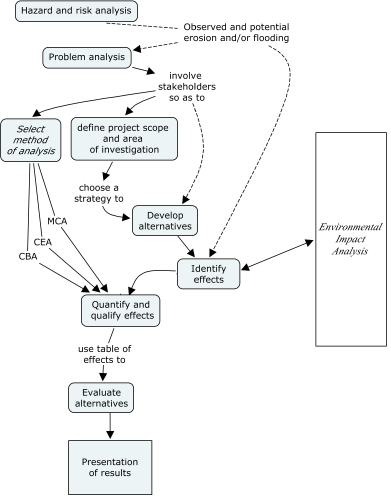Socio-economic evaluation
Contents
Introduction
The overall objective of socio-economic evaluation is to maximize the benefits of future investments in coastline management in a sound and sustainable way. Various forms of Socio-Economic evaluation are used to assist in Coastal Management and making decisions regarding the coastal zone. Any evaluation must have a starting point and purpose. In the case of coastal erosion projects knowledge is needed on "Monitoring and modeling the shoreline", "Engineering the shoreline", "Integrating the shoreline into spatial planning policies" and "Valuating the shoreline". Evaluation can be done in different phases of a project - "ex-ante", "in medias res" or "ex-post" (before, while or after a project is carried out". Regardless which phase of a project the same methods are applied. The steps of an evaluation is shown in the following flowchart:
Main methods of analysis
- Cost-Benefit Analysis (CBA)
- Cost-Effectiveness Analysis (CEA)
- Multi-Criteria Analysis (MCA)
Methods for valuation of effects
- Travel Cost Method (TCM)
- Hedonic Pricing Method (HPM)
- Contingent Valuation Method (CVM)
- Production Factor Method (PFM)
- Prevention Cost Method (PCM)
- Shadow Project Method (SPM)
- Benefit Transfer Method (BTM)
References
- ...
See also
Internal Links
External Links
- Guideline and Case-studies available on Messina project website
Please note that others may also have edited the contents of this article.
|
